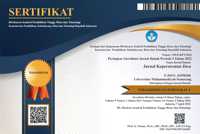Pengaruh Penarikan Smartphone Siswa terhadap Nomophobia, Kecemasan, dan Kesejahteraan Subjektif
(1) STIKES RS Husada
(2) STIKES RS Husada
(3) STIKES RS Husada
(4) STIKES RS Husada
(5) STIKES RS Husada
(6) STIKES RS Husada
(*) Corresponding Author
Abstract
Perkembangan yang pesat pada penggunaan smartphone saat ini menjadikan smartphone menjadi semua kebutuhan, melalui fitur-fitur yang canggih dan dapat memudahkan pekerjaan yang dilakukan. Pesatnya penggunaan smartphone juga tidak terlepas dari adanya factor Pandemi Covid-19 dimana pembelajaran tatap muka berubah dengan cepat menjadi daring. Hal ini mengakibatkan meningkatkan akvititas penggunaan smartphone, selama dua tahun ini. Penggunaan dalam waktu yang lama mengakibatkan munculnya kekhawatiran ketika tidak dapat mengakses smartphone. Oleh sebab itu tujuan dari penelitian ini adalah untuk melihat tingkat adiksi pada responden dan mengetahui tingkat ansietas dan masalah subjevtive well being yang terjadi pada pengguna smartphone. Penelitian ini adalah penelitian quasi experiment pre post test without group control dan menggunakan total sampling, dan data diolah menggunakan dependent t test. Hasil menunjukan bahwa responden mengalami nomophobia sedang yaitu 48,4% dan nomophobia berat sebanyak 41,7%. Ansietas mengalami kenaikan sebesar 6,97% dari sebelum intervensi sedangkan sebanyak 27,21% responden mengalami penururan subjective well being selama sebelum dan sesudah intervensi smartphone withdrawal. Kebutuhan atas edukasi terhadap dampak dari adiksi sangat dibutuhkan untuk mencegah masalah psikologis dari adiksi yang muncul. Edukasi ini dapat dimulai dari penyediaan edukasi mental health dalam menggunakan smartphone disekolah.
Keywords
References
Ayar, D., & Bektas, M. (2021). The Effect of Problematic Internet Use and Digital Game Addiction in Adolescents on Nomophobia Levels. International Journal of Caring Sciences, 14(2), 1081.
Badan Pusat Statistik. (2020). jumlah penduduk menurut generasi. https://www.bps.go.id/
Fitria, D. (2022). View of Dampak Covid-19 : Stres pada Orang Tua dengan Kejadian Emotional Abuse pada Pembelajaran Jarak Jauh (PJJ). https://ejournal.stikesrshusada.ac.id/index.php/jkh/article/view/138/63
Fitria, D., Puspasari, J., & Lestari, P. H. (2021). The Effect of Thinking Like a Nurse Simulation as an Online Clinical Learning Method on Nursing Students’ Satisfaction and Confidence during the Covid-19 Pandemic. Jurnal Ners, 16(2), 111–118. https://doi.org/10.20473/JN.V16I2.25701
Goodstats. (2022). Mengulik Perkembangan Penggunaan Smartphone di Indonesia - GoodStats. 2022. https://goodstats.id/article/mengulik-perkembangan-penggunaan-smartphone-di-indonesia-sT2LA
Hawi, N. S., & Samaha, M. (2017). The Relations Among Social Media Addiction, Self-Esteem, and Life Satisfaction in University Students. Social Science Computer Review, 35(5), 576–586. https://doi.org/10.1177/0894439316660340
Kaur, A., Ani, A., Sharma, A., & Kumari, V. (2021). Nomophobia and social interaction anxiety among university students. International Journal of Africa Nursing Sciences, 15, 100352. https://doi.org/10.1016/j.ijans.2021.100352
King, R. C., & Dong, S. (2017). The impact of smartphone on young adults. The Business & Management Review, 8(4), 342. https://getit.library.utoronto.ca/index.php/oneclick?ctx_ver=Z39.88-2004&ctx_enc=info%3Aofi%2Fenc%3AUTF-8&rfr_id=info%3Asid%2Fsummon.serialssolutions.com&rft_val_fmt=info%3Aofi%2Ffmt%3Akev%3Amtx%3Ajournal&rft.genre=article&rft.atitle=The+impact+of+smartph
Kominfo. (2022). Kemenkominfo: 89% Penduduk Indonesia Gunakan Smartphone. https://mediaindonesia.com/humaniora/389057/kemenkominfo-89-penduduk-indonesia-gunakan-smartphone
Lavoie, R., & Zheng, Y. (2023). Smartphone use, flow and wellbeing: A case of Jekyll and Hyde. Computers in Human Behavior, 138, 107442. https://doi.org/https://doi.org/10.1016/j.chb.2022.107442
Matar Boumosleh, J., & Jaalouk, D. (2017). Depression, anxiety, and smartphone addiction in university students- A cross sectional study. PloS One, 12(8). https://doi.org/10.1371/JOURNAL.PONE.0182239
Newzoo. (2021). 2021’s Mobile Market: Insights into Users, Game Revenues & Key Trends. https://newzoo.com/insights/articles/2021s-mobile-market-almost-four-billion-smartphone-users-90-7-billion-in-game-revenues-huge-changes-to-come
Rodríguez-García, A. M., Belmonte, J. L., & Moreno-Guerrero, A. J. (2020). Nomophobia: An individual’s growing fear of being without a smartphone—a systematic literature review. International Journal of Environmental Research and Public Health, 17(2). https://doi.org/10.3390/ijerph17020580
Rodríguez-García, A. M., Marín-Marín, J. A., López-Núñez, J. A., & Moreno-Guerrero, A. J. (2021). Do age and educational stage influence no-mobile-phone phobia? International Journal of Environmental Research and Public Health, 18(9). https://doi.org/10.3390/ijerph18094450
Rossa, E., & Martina, M. (2016). HUBUNGAN SMARTPHONE ADDICTION DENGAN KECENDERUNGAN NOMOPHOBIA PADA MAHASISWA FAKULTAS KEPERAWATAN UNIVERSITAS SYIAH KUALA. Undefined.
Rotondi, V., Stanca, L., & Tomasuolo, M. (2017). Connecting alone: Smartphone use, quality of social interactions and well-being. Journal of Economic Psychology, 63, 17–26. https://doi.org/10.1016/j.joep.2017.09.001
Santl, L., Brajkovic, L., & Kopilaš, V. (2022). Relationship between Nomophobia, Various Emotional Difficulties, and Distress Factors among Students. European Journal of Investigation in Health, Psychology and Education, 12(7), 716–730. https://doi.org/10.3390/ejihpe12070053
Saraswathi, K. N., & Williams, S. (2019). A Study to Assess the Knowledge and Effect of Nomophobia among Nursing Students of selected Nursing Colleges in Mysore. International Journal of Nursing Education and Research, 7(3), 330. https://doi.org/10.5958/2454-2660.2019.00075.9
Shaik, L., Singh, R., Devara, J., Basa, P., & Shah, K. (2021). Psychiatric impact of mobile usage on medical student life: Ringxiety, nomophobia, and sleep. European Psychiatry, 64(S1), S395–S395. https://doi.org/10.1192/j.eurpsy.2021.1059
Spitzer, R. L., Kroenke, K., Williams, J. B. W., & Löwe, B. (2006). A brief measure for assessing generalized anxiety disorder: the GAD-7. Archives of Internal Medicine, 166(10), 1092–1097. https://doi.org/10.1001/ARCHINTE.166.10.1092
Tams, S., Legoux, R., & Léger, P. M. (2018a). Smartphone withdrawal creates stress: A moderated mediation model of nomophobia, social threat, and phone withdrawal context. Computers in Human Behavior, 81, 1–9. https://doi.org/10.1016/j.chb.2017.11.026
Tams, S., Legoux, R., & Léger, P. M. (2018b). Smartphone withdrawal creates stress: A moderated mediation model of nomophobia, social threat, and phone withdrawal context. Computers in Human Behavior, 81, 1–9. https://doi.org/10.1016/J.CHB.2017.11.026
Vujić, A., & Szabo, A. (2021). The connection between risk of smartphone addiction, type of smartphone use, life satisfaction, and perceived stress dataset. Data in Brief, 39, 107651. https://doi.org/10.1016/j.dib.2021.107651
Yildirim, C., & Correia, A. P. (2015). Exploring the dimensions of nomophobia: Development and validation of a self-reported questionnaire. Computers in Human Behavior, 49, 130–137. https://doi.org/10.1016/J.CHB.2015.02.059
Yildiz Durak, H. (2019). Investigation of nomophobia and smartphone addiction predictors among adolescents in Turkey: Demographic variables and academic performance. Social Science Journal, 56(4), 492–517. https://doi.org/10.1016/j.soscij.2018.09.003
Article Metrics
Abstract view : 758 timesUntitled - 0 times PDF - 314 times
DOI: https://doi.org/10.26714/jkj.10.4.2022.865-874
Refbacks
- There are currently no refbacks.

This work is licensed under a Creative Commons Attribution 4.0 International License.
PPNI Univ. Muhammadiyah Semarang
Jl. Kedungmundu Raya No. 18 Semarang Gedung NRC University of Muhammadiyah Semarang
Phone: 02476740287
Fax: 02476740287
Email: jurkep.jiwa@gmail.com
This work is licensed under a Creative Commons Attribution 4.0 International License.


